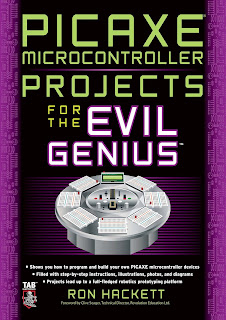|
|
PICAXE Microcontroller Projects for the Evil Genius
Ron Hackett
|
|
|
Whip up some fiendishly fun
PICAXE microcontroller devices.
"Ron has worked hard to explain how the PICAXE system operates through simple examples, and I'm sure his easy-to-read, style will help many people progress with their PICAXE projects."
This wickedly inventive guide shows you how to program, build, and debug a variety of PICAXE microcontroller projects. PICAXE Microcontroller Projects for the Evil Genius gets you started with programming and I/O interfacing right away, and then shows you how to develop a master processor circuit.
|
Estimular algunos endiabladamente divertidos dispositivos microcontroladores PICAXE.
"Ron ha trabajado duro para explicar cómo el sistema PICAXE opera a través de ejemplos sencillos, y estoy seguro de que su estilo fácil lectura, contribuirán al progreso de muchas personas con sus proyectos PICAXE".
Esta guía de perversa inventiva que muestra cómo programar, construir y depurar una serie de proyectos microcontroladores PICAXE. Proyectos PICAXE microcontroladores para el genio malvado es comenzar con la programación y la E / S de la interfaz de inmediato, a continuación, muestra cómo el desarrollo de un circuito procesador maestro.
|
|
|
- PICAXE Basics.
- Introduction to PICAXE Programming and Projects
- Introduction to Stripboard Circuits
- Designing and Building a +5V Regulated Power Supply
- Hardware Overview of the PICAXE M2-Class Processors
- The Ins and Outs of PICAXE Interfacing
- Introduction to ADC Inputs on M2-Class Processors
- PICAXE Peripheral Projects.
- Introduction to the PICAXE-20X2 Processor
- Infrared Input from a TV Remote Control
- Interfacing Parallel LCDs
- Serializing a Parallel LCD
- Interfacing Keypads
- SPI Communication
- Background Timing on the 20X2 Processor
- Constructing a Programmable Multifunction Peripheral Device
- Developing Software for the Evil Genius MPD
- Octavius: An Advanced Robotics Experimentation Platform.
- Birthing Octavius
- Driving Octavius
- Programming Octavius
Consulta el Libro (9 MB) por TurboBit y MediaFire: |
|
|
|
|
|
|
|
- PICAXE Basics.
- Introduction to PICAXE Programming and Projects. Choosing a PICAXE Processor. Interfacing a Project with Your Mac or PC. Using RevEd’s Free Programming Editor or AXEpad Software. Programming in PICAXE BASIC. Breadboards, Stripboards, and PC Boards. “Hello World”. Debugging a PICAXE Project.
- Introduction to Stripboard Circuits. Designing Stripboard Circuits. Tools for Stripboard Circuit Construction. The USBS-PA3 PICAXE Programming Adapter. Hello Again.
- Designing and Building a +5V Regulated Power Supply. Designing a +5V Regulated Power Supply for Breadboard Circuits. More Power, Scotty!.
- Hardware Overview of the PICAXE M2-Class Processors. General-Purpose Variables. Storage Variables. Special-Function Variables. Cylon Eye.
- The Ins and Outs of PICAXE Interfacing. PICAXE I/O Interfacing. Setting Up an Interrupt Routine. Mary.
- Introduction to ADC Inputs on M2-Class Processors. Voltage Dividers. A Three-State Digital Logic Probe.
- PICAXE Peripheral Projects.
- Introduction to the PICAXE-20X2 Processor. Advanced Features of the 20X2 Processor. Implementing the 20X2 Master Processor Circuit.
- Infrared Input from a TV Remote Control. Reception and Transmission of Standard TV IR Signals. IR-Based Serial Communications. Simple IR Object-Detection. Experiment 1: A Simple TV-IR Input Circuit. Experiment 2: Interfacing the IR Circuit with the Master Processor. Constructing the TV-IR Input Module.
- Interfacing Parallel LCDs. Understanding the Basics of HD44780-based LCDs. Experiment 1: Interfacing an HD44780-based Parallel LCD. Constructing an Eight-bit Parallel 16 x 2 LCD Board. Programming Challenge.
- Serializing a Parallel LCD. Receiving Serial Data in the Background. Constructing a Serialized 16 x 2 LCD.
- Interfacing Keypads. Decoding Matrix Keypads. Constructing a Serialized 4 by 4 Matrix Keypad.
- SPI Communication. The MAX7219 8-Digit LED Display Driver. Constructing an SPI 4-Digit LED Display. Learning to Count.
- Background Timing on the 20X2 Processor. Using Timer1 on the 20X2 Processor. “Deconstructing” a Matrix Keypad. Testing the “New and Improved” Keypad. Constructing a Countdown Timer.
- Constructing a Programmable Multifunction Peripheral Device. The Evil Genius Multifunction Peripheral Device.
- Developing Software for the Evil Genius MPD. Understanding the 20X2’s Built-in Comparator Hardware. Testing Our Comparator 1 Configuration. “We Interrupt This Program to Bring You a Keypress!”. A Simple MPD Operating System.
- Octavius: An Advanced Robotics Experimentation Platform.
- Birthing Octavius. Understanding Octavius. Building Octavius.
- Driving Octavius. H-Bridge Motor Control Circuits. The L298 Dual H-Bridge Driver. Constructing an L298 Dual DC Motor Controller Board.
- Programming Octavius. The MaxBotix LV-MaxSonar Ultrasonic Range Finders. Who’s in Charge Here?. Hail, Octavius!. Epilogue: What’s Next for Octavius?.
|

No hay comentarios:
Publicar un comentario
Me gustaría Saber: Quién eres y de Donde Eres. Deja de Ser un Anónimo. Que tengas un Buen Día.